Evolution of the Griswold Trademark

Selden & Griswold
Matthew Griswold had been making cast iron hollow ware for the better part of two decades before first putting the Griswold name on a skillet. Having been in business with his cousins, the Selden brothers, since 1868, the name Griswold was originally seen in the mark "Selden & Griswold", on various pieces of hollowware. Griswold bought out his relatives' interest in 1884.
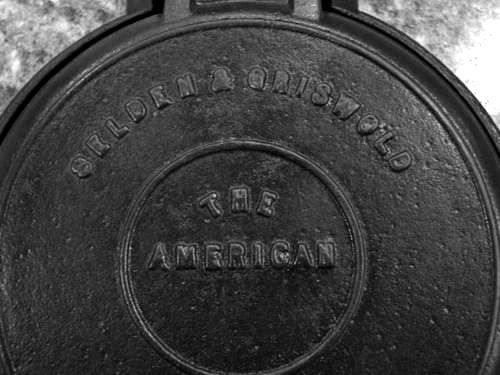
Selden & Griswold trademark on a waffle iron.
Erie Diamond and Griswold's Erie
The name Griswold alone on a trademark would then first appear on a handful of pieces in the form of Griswold's first stylized logo, known as the "Griswold's Erie Diamond", and next when the sixth series "ERIE" skillets were changed to read "GRISWOLD'S ERIE", around 1906. This second trademark containing the Griswold name would be short lived, however, as traditional block lettering would begin to be replaced by stylized logos by many makers.

Griswold's Erie Diamond logo.

Griswold's Erie trademark.
The last surviving text-only trademark would continue to be seen on the Victor economy line of skillets, to which "THE GRISWOLD MFG. CO." had been added mid-way through their period of manufacture.
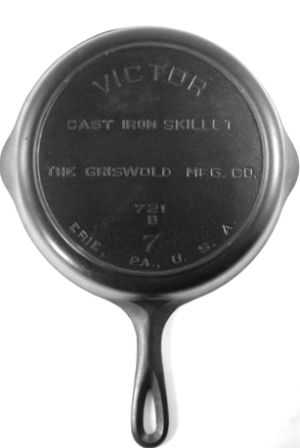
Griswold's Victor, fully marked.
The "Slant" Logo
The first "Griswold" trademark to be used across virtually all production, and perhaps the most iconic, is known as the "slant logo". As with later Griswold trademarks, it consisted of a cross inside a double circle, with the name GRISWOLD spanning the horizontal arms of the cross. "Slant" because of the stylized italic lettering used for the name. While "trademark" is the more properly applicable term, "logo" is often used and should not be regarded as incorrect.
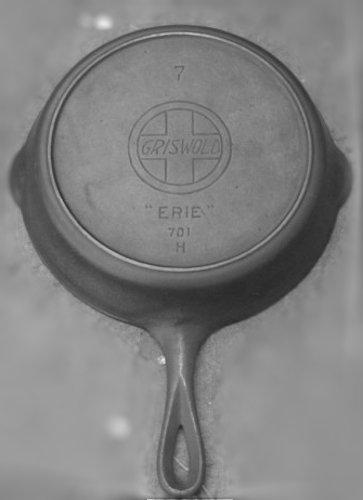
Griswold slant logo.
The slant logo was generally of the same diameter on most pieces, with exceptions made for pieces like lids, where a reduced size version was used.
There exist a few pieces with what is sometimes for lack of a better term called a medium slant logo. Slightly smaller and proportionally different from the normal slant, it may have been the result of a prototype pattern being used for actual production.

Griswold medium slant logo.
The slant logo was seen on both heat ringed and in rare cases smooth bottom skillets, as well as on pans marked "ERIE" and "ERIE, PA, U.S.A.", being referred to by collectors as "Slant Erie" and "Slant EPU", respectively.
On the older, "ERIE" marked pieces, the slant trademark was typically not as heavily incised as on the later "ERIE, PA, U.S.A." pans.

Griswold slant logo, with heat ring and EPU.
The slant logo's use would continue for some time into the large block logo era, with old patterns seen modified to add the other inscriptions characteristic of the large block pieces. It would be some 10 years before the slant logo disappeared from production altogether.
The "Large Block" Logo
Later, around 1920, the slant logo was updated, with the lettering being changed to a block style. The overall weight of the logo would become more bold as well. This logo would come to be known as the "large block logo" or "LBL", the "large" referring to the lettering and differentiating it from a later revision with smaller lettering. The addition of descriptive markings such as "CAST IRON SKILLET" and the appending of ", PA, U.S.A." to the "ERIE" made the LBL markings more complex than on any other Griswold skillet, and perhaps the most attractive to collectors.

Griswold Large Block logo with heat ring.

Griswold Large Block logo with smooth bottom.
Some minor variations in the large block logo are seen, most notably on the #4 and #5 smooth bottom skillets. On these, the lettering is proportionally not as tall as on most.

Griswold #5 Large Block logo.
The large block logo also is seen on both heat ring and smooth bottom skillets, but only with the "ERIE, PA, U.S.A." designation.
The "Small Block" Logo
About 1939, the logo was reduced in size, likely the result of all but the largest skillet patterns being replaced outright, rather than just being modified, as was previously seen. This assumption is borne out by the lack of "ghost" markings being seen on most of these later pieces. Along with the logo shrinkage, the overall weight of the lettering, cross, and circles was reduced, and inscriptions like "CAST IRON SKILLET" were eliminated. The "ERIE, PA, U.S.A." was also shortened to "ERIE, PA.". As such, it would appear the markings were made plain enough to simply be stamped into blank working patterns. This trademark would be known to collectors years later as the "small block logo", abbreviated "SBL".
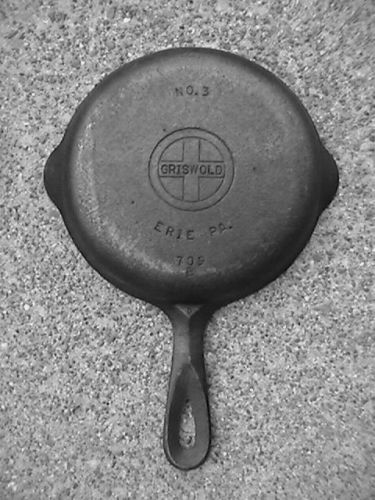
Griswold Small Block logo, early handle.
Slant Logo Smooth Bottom Skillets
At some point, the slant logo made a brief appearance on a handful of smooth bottom skillet sizes. Exactly when and why is uncertain. Some date them the same as the similarly marked heat ring versions, while others place them much later, early in the small block era. Wagner had introduced their smooth bottom skllets ca. 1935, so there is a possibility these Griswold smooth bottoms were produced around that time as well.
The old catalogs don't seem to be of much help in clarifying this issue. Were both heat ring and smooth bottom versions offered simultaneously, or were the obsolete heat-ringed patterns perhaps dug out at some alter time and modified into smooth-bottomed simply to provide enough working patterns to keep up with demand? In either case, the scarcity of these pieces makes them highly collectible.
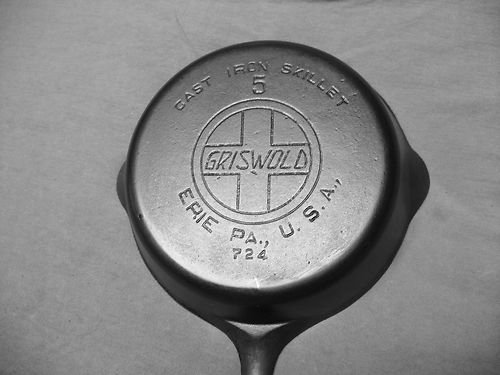
Griswold Slant logo on smooth-bottomed skillet.
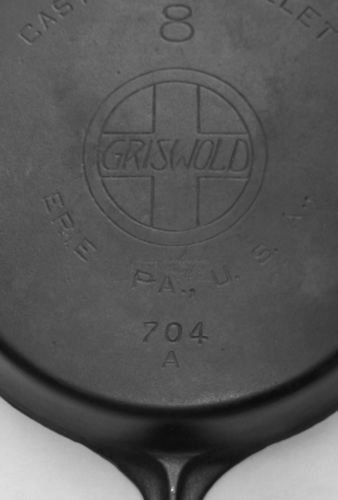
Griswold Slant logo on smooth-bottomed skillet with ERIE ghost.
Medium Block aka "Late Large" Logo
Briefly, around 1955 according to dateable examples, it appears the logo was once again poised for revision. Only seen on a few different pieces, this logo was essentially a smaller version of the "large block", but still larger than the "small block". This logo is known to collectors as the "medium block", or sometimes the "late large logo".
The original large block logo had appeared in different sizes, dependent on the piece upon which it was inscribed. Although smaller than that on a #8 skillet, the logo on a size #0 toy skillet is still considered a large block logo. What differentiates the late large logo is the fact that it does not appear on pieces also marked "ERIE, PA U.S.A.", but only on those marked "ERIE, PA" in the smaller font seen with small block logo pieces.
It is theorized that this logo might have replaced the small block across the entire line had Griswold not been bought out by the company which also owned Wagner.

Griswold Medium Block or Late Large logo.

Griswold Medium Block or Late Large logo.

Griswold Medium Block or Late Large logo.

Griswold Medium Block or Late Large logo Square Skillet.
Raised Logo
Although normally incised, the trademark was in some instances seen as raised, these being confined mainly to the tops of some lids, implements like food choppers, and, as was normal for all but the earliest Griswold designs, their waffle irons. (Raised markings were typically not seen on surfaces subject to constant wear, and, if so, such practice was usually quickly abandoned.) When seen on an iron or aluminum lid, the trademark is referred to as the "button logo", and is in some cases seen with only a single circle.

Griswold button logo, double circle.
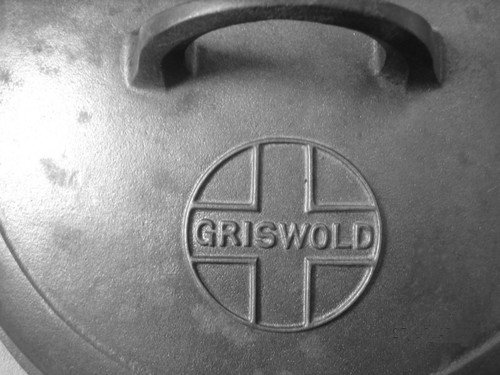
Griswold button logo, single circle.
Cross-in-Double-Circle Logo In Print
A paradox exists between the logo as most commonly seen incribed on the cookware and that seen on Griswold printed publications such as catalogs, bulletins, and on letterhead. In print, the tips of the cross are closed by straight lines, whereas on the cast iron, it is the inside circle which forms the boundaries. Only on a few pieces, typically cast aluminum, does the logo have the additional line segments seen on the printed logo. Additionally, the print logo typically has the lettering in the early slant style.

Griswold print logo.
Post-Acquisition Variations
The Griswold trademark would undergo more changes after the acquisition by Wagner. It would appear the company which owned Wagner was more interested in only using the Griswold name and not so much its classic designs. Griswold-marked pieces after the buy-out appear to be from modified Wagner patterns, with hastily-concocted versions of the Griswold trademark applied. Use of the Griswold trademark in any form would be discontinued after 1973.

Griswold logo applied to a Wagner pattern.

Griswold logo applied to a Wagner pattern, with Made In USA.

Griswold logo with no cross applied to a Wagner pattern.

Griswold Wagner dual logo.
Dating The TMs
Using this table, the approximate time period of manufacture of a Griswold trademarked skillet can be determined.
| Griswold TM | Selden & Griswold | Diamond Logo | Griswold's Erie | "Slant" Logo | Large Block | Small Block | Late Large | |
| Time Period | 1870-1890 | 1884-1909 | 1905-1906 | 1906-1929 | 1939-1944 | 1920-1940 | 1939-1957 | 1955-1957 |
| Heat Ring | N/A¹ | N/A¹ | Yes | Yes | No | Yes, No | No² | No |
| Heat Ring Type | N/A | N/A | Inset | Inset | None | Inset, None | Inset² | N/A |
¹Trademark apparently not used on skillets.
²Sizes 12 and above have (inset) heat rings.








